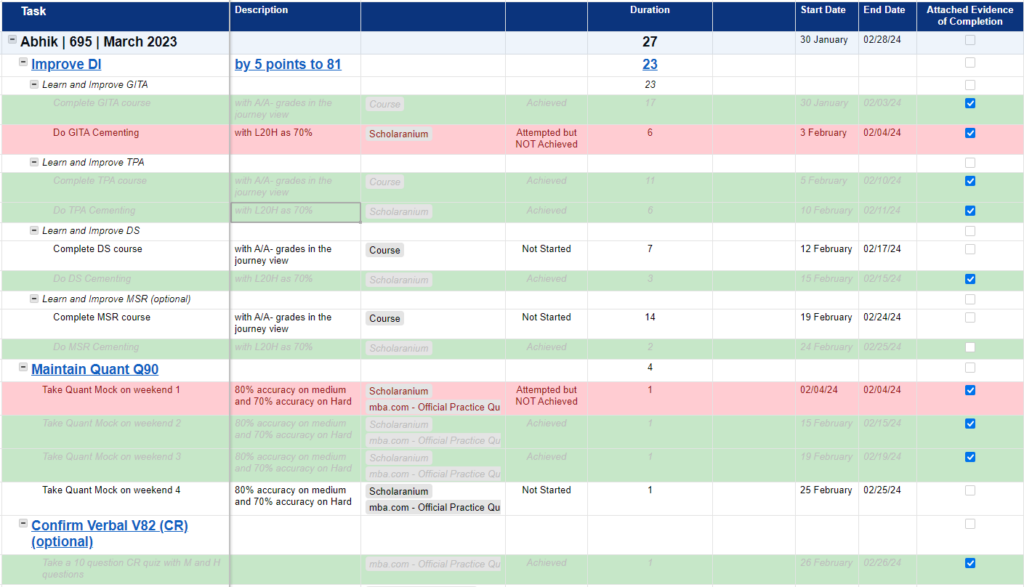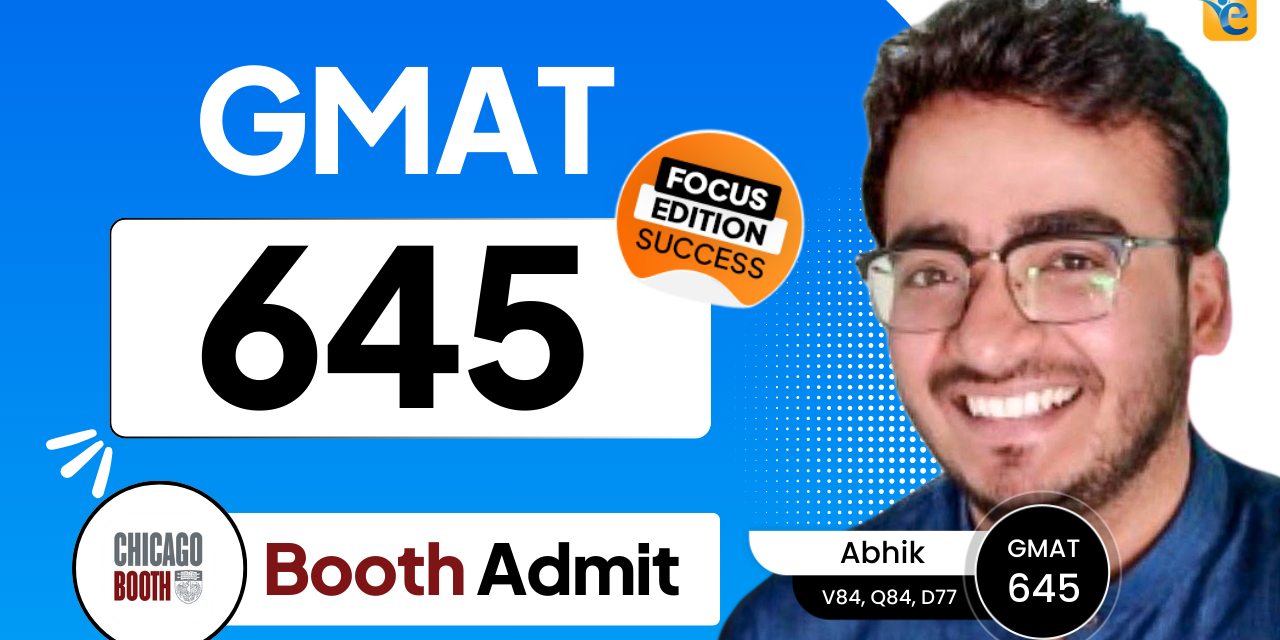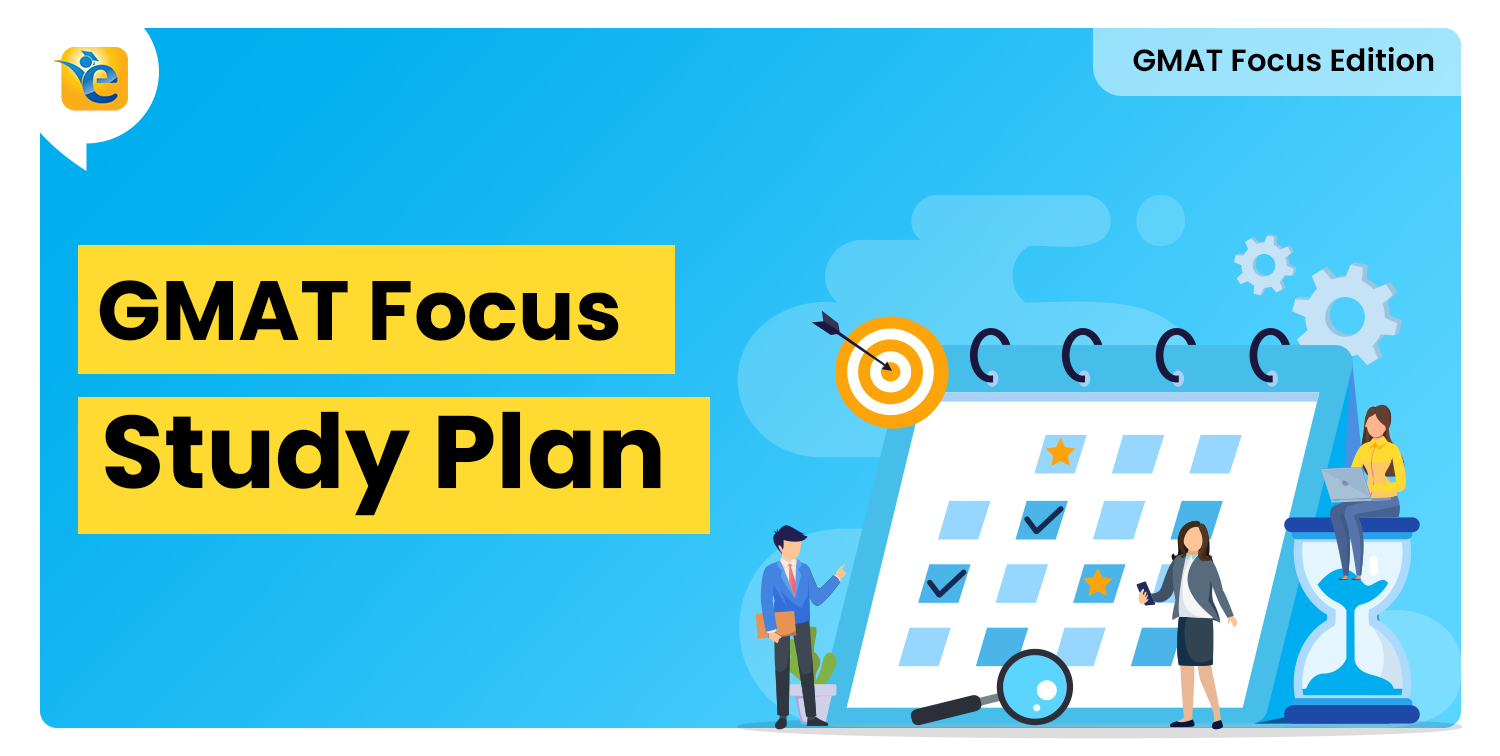Introduction
Abhik’s GMAT voyage is a narrative of relentless perseverance, strategic mastery, and ultimate triumph, culminating in a commendable 645 score and securing a coveted spot at the University of Chicago’s Booth School of Business. Juggling the roles of the parent of a precious 2-month-old, a full-time professional, and a GMAT aspirant, Abhik overcame formidable challenges with a disciplined approach and unwavering dedication. His story is not just about personal achievement but also a testament to the power of targeted preparation and the impact of supportive mentors and family. Watch Abhik’s inspirational journey here:
In this article, we explore the following aspects of Abhik’s journey to Booth:
- Overcoming Preparation Constraints: Discover how Abhik managed his time around a 2-month-old baby and a full-time job to craft a successful GMAT study regime.
- Structured Study Plan: Witness the transformation that a meticulously crafted study plan by Payal brought into Abhik’s preparation, aligning perfectly with e-GMAT’s and Booth’s common philosophy.
- Verbal Section Preparation: From struggling with a 7th percentile in Critical Reasoning to mastering Reading Comprehension, explore Abhik’s verbal voyage that led him to a V84, a 91st percentile in Verbal overall.
- Cementing: Learn how crossing the accuracy threshold in cementing quizzes became a game-changer for Abhik, instilling in him the confidence to excel.
- Error Log: Delve into the significance of maintaining an error log, a critical tool that helped Abhik identify patterns in his mistakes and improve his precision.
- GCE Verbal to GFE Verbal: Understand Abhik’s seamless transition from GMAT Classic Edition to GMAT Focus Edition, saving him from the hassles of adapting between SC and CR/RC.
- Quantitative Section Enhancement: Follow Abhik’s quant journey, where targeted practice using Scholaranium led to a significant score improvement.
- Integrated Reasoning & Data Insights (DI): Abhik shares his strategies for excelling in the adaptive DI section, overcoming timing challenges, and leveraging his strengths.
- Test Day Experience & Lessons: Learn how a technical glitch cost Abhik vital points in the final section of his exam; read how he navigated these and the lessons he garnered.
- MBA Application Process: A peek into Abhik’s meticulous MBA application and interview journey and to Booth, emphasizing the importance of self-reflection and clear goal-setting.
- Importance of Support System: Discover how the unwavering support from family, interaction with Booth alumni, and mentorship at e-GMAT played a crucial role in Abhik’s success.
Outline:
- Overcoming Preparation Constraints
- Structured Study Plan
- Verbal Section Preparation
- Cementing
- Error Log
- GCE Verbal to GFE Verbal
- Quantitative Section Enhancement
- Integrated Reasoning & Data Insights (DI)
- Test Day Experience & Lessons
- MBA Application Process
- Importance of Support System
Overcoming Preparation Constraints:
Abhik’s journey culminated amidst the demanding responsibilities of first-time parenthood and a full-time job. He had decided to switch from the GMAT Classic edition to the GMAT Focus around the end of January, 2024, and had only 3 weeks to complete his prep. He had to find a way to achieve that delicate balance between personal and professional commitments and his aspirations. Meticulous planning and time management, par excellence, were pivotal in navigating these challenges.
“Decided to do GMAT Focus around the end of January… Had 3 weeks to complete the DI course. It was difficult to take out even 2 hours a day, but somehow I managed by taking out time during the day and meeting my study commitments” (Abhik).
Structured Study Plan:
Payal formulated a customized study plan for Abhik, a strategy that acted as a compass throughout his GMAT journey. This direct approach not only streamlined his preparation for each section but also provided a clear structure and tangible goals, cutting out any guesswork from his study routine. Abhik credited this plan with fostering a sense of accountability and allowing him to systematically track his progress.

This structure resonated deeply with Abhik, mirroring not only the ethos of e-GMAT but also his personal beliefs and the values upheld by Chicago Booth.
“That’s what Booth also values … a structured way of doing things,” (Abhik)
Verbal Section Preparation:
Critical Reasoning (CR):
Abhik’s journey through the Critical Reasoning (CR) section was transformative, moving from a meager 7th percentile to an impressive 85th percentile. Initially, his approach lacked structure; he would often choose answers based on intuition rather than understanding.
“CR personally was… like a touchy-feely thing… I didn’t understand fully what the question was asking,” Abhik recalled.
The introduction of pre-thinking techniques marked a significant shift in his strategy, enabling him to dissect arguments logically and identify underlying assumptions. Abhik emphasized the impact of this method, stating,
“Pre-thinking was a game-changer… It gives you a structured approach to CR.”
This structured approach allowed him to improve not only his CR scores but also his test-taking behavior, crediting sessions with e-GMAT mentors Payal, Rajat, and Rida for helping him refine his strategies and mindset towards tackling CR questions effectively.

Reading Comprehension (RC):
In Reading Comprehension (RC), Abhik’s progress was equally remarkable. He transitioned from passive to active reading, which significantly enhanced his comprehension and analytical skills. This change was crucial not just for GMAT success but also for improving his overall reading habits, like when he would read the Wall Street Journal.

Abhik found particular value in the Master Comprehension course offered by e-GMAT, which laid the groundwork for effective reading strategies.
“Master comprehension… really helped me… to identify the pause points properly, to understand what the author is trying to say” he shared.
His newfound abilities in strategic pausing and focusing on keywords were instrumental in navigating through passages more efficiently, demonstrating that understanding both the explicit and implicit messages of a text is crucial in both CR and RC sections. This holistic improvement in verbal reasoning underscored the importance of a structured learning path and the benefits of active engagement with the material.
Cementing:
The cementing phase of Abhik’s GMAT preparation played a crucial role in elevating his confidence and solidifying his mastery of the material. This process involved taking quizzes of varying difficulty levels, which were instrumental in assessing his readiness for the actual GMAT. Despite not always meeting the threshold on his first attempt, Abhik felt a profound sense of support from his mentors at e-GMAT, including Rida, Rajat, and Payal.
“e-GMAT always had my back, and that made all the difference,” he expressed.
Crossing the accuracy threshold in these cementing quizzes marked a significant turning point for Abhik. Achieving a 70% accuracy rate in medium quizzes and then 55% in hard quizzes was, for him, akin to overcoming a mental barrier, transforming his self-doubt into a resolute belief in his capabilities.
Abhik appreciates the quality and rigor of the practice material that closely mirrored the complexity of the actual GMAT questions.
“e-GMAT’s questions are not easy. They are a good replication of official GMAT Questions,” Abhik noted.
He even pointed out that each success in cementing fueled his motivation to tackle greater challenges.
“Okay, so I was able to achieve this. What next?!” (Abhik)
Moreover, the detailed feedback provided after each quiz proved invaluable to Abhik. The metrics, including the TAKT time for each question and percentile data for each answer choice, offered him insights into his performance and areas needing improvement.


Error Log:
Abhik’s approach to the GMAT preparation highlighted a crucial yet often overlooked tool: the error log. Despite admitting to not being the ideal student in consistently maintaining it, he realized its undeniable importance, particularly when faced with a plateau in his scores.
“If you fill and revise your error log consistently, you’ll know that there’s a trend in your mistakes. It helped me identify the root cause of my problems,” Abhik.
His journey through the challenging terrain of Boldface questions in Critical Reasoning (CR) sections showcased the practical benefits of an error log. Abhik found himself repeatedly tripped up not by the questions themselves but by the nuances in the answer choices.
“What is a belief? What is a consideration? Can a fact be used as evidence? I fell for these words every single time.” (Abhik)
This admission highlights a common hurdle for many test-takers, where the devil lies in the detail of understanding the language and logic of GMAT questions.
“The error log helped me identify and fix these mistakes. And, it’s an evolving process. You fix some mistakes, then you make new and better mistakes, and you then work on those,” he shared.

This iterative process of learning from errors, adjusting strategies, and tackling new challenges head-on was instrumental in achieving his impressive V84 score, demonstrating a 90th percentile ability overall in verbal.
GCE Verbal to GFE Verbal:
The transition from the GMAT Classic Edition (GCE) to the GMAT Focus Edition (GFE) proved to be a strategic advantage for Abhik, aligning more closely with his strengths and study preferences. In his experience, the GFE’s verbal section resonated better with his preparation style and personal capabilities. He observed a significant overlap in the skills tested in Critical Reasoning (CR) and Reading Comprehension (RC), noting, “CR and RC are a lot similar in terms of the skills tested.” This similarity allowed him to apply a unified approach to both areas, streamlining his study process and improving efficiency.
Abhik’s proficiency in Sentence Correction (SC) was undeniable, yet he encountered difficulties when switching between the skill sets required for SC and those for CR and RC. This transition often proved to be a stumbling block, impacting his overall performance. The elimination of SC in the GFE, however, meant that he could focus on honing a singular set of skills applicable across the entire verbal section.
“With SC gone, all questions in verbal practically had to the same approach. So, very little adaptability required, and that helped Abhik,” he reflected.
Quantitative Section Enhancement:
Despite his solid base, Abhik was determined to elevate his quant abilities to new heights. Utilizing e-GMAT’s PACE Architecture (Personalized, Adaptive Course Engine), he was able to zero in on specific areas that needed improvement, such as Word Problems involving Profit and Loss, and Discount.
“The diagnostic quizzes of the PACE Architecture helped me isolate these areas and helped me save a lot of time by not having to cover topics I was already good at,” (Abhik)
Further enhancing his quant skills, Abhik turned to Scholaranium. This platform provided him with a wealth of resources to fine-tune his accuracy and consistency, particularly in challenging areas like Permutations, Combinations, and Probability.
“Scholaranium gave me the tools to work on improving my accuracy and consistency,” (Abhik)

Integrated Reasoning & Data Insights (DI):
Abhik entered the Integrated Reasoning (IR) and Data Insights (DI) sections with confidence, having historically performed well in IR. However, the transition to the adaptive DI section required a shift in strategy, especially as he noted the reduced time per question from over 2.5 minutes in IR to less in DI. Abhik faced challenges with timing, particularly on medium DI questions, which could take him 3.5 to 4 minutes to solve.
“Even a small error in the way you look at a graph, and you’re going to make a mistake,” (Abhik)
Thankfully, e-GMAT’s course and the guidance of mentors Payal, Rajat, and Rida equipped him with strategies to effectively manage these constraints, enhancing his performance. The migration of Data Sufficiency (DS) questions to the DI section played to his strengths, allowing him to excel and even achieve a 100th percentile in DS, thus freeing up valuable time for other types of DI questions.
Abhik recognized Graphical Interpretation as a particular area of weakness, but with targeted practice through the course, he significantly improved his skills in interpreting graphs and making rapid calculations. He strongly endorses the DI course, advising, “I would highly recommend the DI course to everyone; you must take advantage of it.” Abhik’s journey through IR and DI reflects the importance of adaptability and targeted preparation in overcoming new challenges presented by the GMAT.

Test Day Experience & Lessons:
Abhik’s test day brought to light a crucial lesson stemming from an unexpected technical glitch during the final moments of his exam. Despite having enough time to answer the last question and confidently selecting his response, a discrepancy in the score report later revealed that the question was marked as “unanswered.”
The officials clarified that the issue arose because Abhik clicked the final “okay” button for submission just as the test concluded, effectively missing the submission window by a fraction of a second. This led to a disappointing D77 in his score report.
This incident highlighted a significant aspect of the testing experience: the substantial penalty for leaving a question unanswered, which is considerably more severe than submitting an incorrect answer. Abhik reflected on this situation as a critical learning moment, accepting his score of 645 but also recognizing the broader implications for future test-takers.
Abhik’s experience serves as a cautionary tale, urging others to meticulously manage their time and responses during the exam to avoid similar pitfalls.
MBA Application Process:
Abhik’s journey to an MBA at Chicago Booth is a story of persistence, self-reflection, and meticulous planning. After being waitlisted at both Booth and Ross, his unwavering clarity on his goals and deep understanding of his “why” ultimately secured his admission to Booth.
“See, for Booth, they need to know your ‘why’. ‘Why’ is very important for them,” (Abhik)
Click here for Rajat and Payal’s recipe for the right answer to your “Why”, published recently in e-GMAT’s weekly Coffee with Rajat & Payal session.
The path to acceptance involved more than just understanding his objectives; it required a thorough exploration of what Booth could offer him. Working with a consultant, Abhik engaged in detailed research on the courses, faculty, and research opportunities at Booth, integrating these findings into his application essays and interviews to paint a comprehensive picture of how the MBA program would serve his future.
Abhik also highlighted the critical role of authenticity in the application process, particularly during interviews.
“Being yourself and ‘being authentic’… if you know yourself, it will come out naturally and with confidence,” he remarks.
This authenticity, coupled with a strong sense of self and purpose, not only helped Abhik stand out but also demonstrated his fit and readiness for the transformative journey at Booth.
Importance of Support System:
Abhik’s journey to MBA success was significantly bolstered by a robust support system, comprising his wife, his father, e-GMAT mentors, and the Booth community. The encouragement and insight he received from his close family were indispensable during both the preparation and application phases. His wife’s support was particularly crucial, providing the emotional backbone needed to persevere through challenges. Meanwhile, his father’s deep understanding of Abhik’s character and thought processes played a pivotal role in shaping his approach to the application essays.
“My father knows me in and out; he knows who I am, how I think,” (Abhik)
Beyond his family, Abhik found a wealth of resources and support within the Booth community itself. Engaging with Booth students and alumni opened up a channel of insights regarding the school’s culture, values, and expectations. This interaction not only informed his application strategy but also reinforced his decision to pursue an MBA at Booth.
“Connecting with alumni and current students will give you the answers. This is what gave me my answers.” (Abhik)
The collective wisdom and encouragement from these diverse sources were instrumental in navigating the MBA application process.
Conclusion:
Abhik’s story is a testament to the power of perseverance, meticulous planning, and the profound impact of a supportive community on achieving one’s goals. His journey through GMAT preparation and the MBA application process demonstrates the comprehensive approach of e-GMAT, which extends beyond mere academic preparation to encompass essential life skills.
Abhik’s resilience and strategic thinking throughout this process serve as a beacon of inspiration for GMAT and MBA hopefuls worldwide. Reflecting on his experience, Abhik expresses deep gratitude towards his mentors and the e-GMAT platform.
“I cannot thank you, Rida, and e-GMAT enough for being such a huge part of this achievement, and hopefully in future as well. e-GMAT is more than just a test prep company; they will genuinely help you achieve your goals,” (Abhik)
This acknowledgment highlights the significant role that dedicated guidance and support play in navigating the complexities of educational and career advancements. Abhik’s GMAT success story is a compelling reminder of the value of determination, precise planning, and the strength found in a supportive network.















